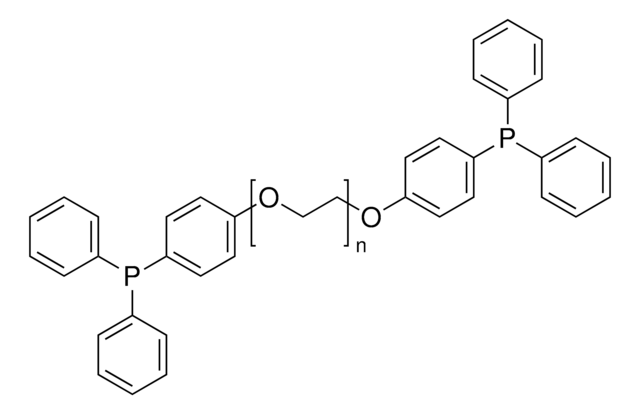93094
Triphenylphosphine, polymer-bound
100-200 mesh, extent of labeling: ~1-1.5 mmol/g Capacity (Phosphor)
Synonym(s):
Copolymer of styrene and divinylbenzene, diphenylphosphinated, Diphenylphosphino-polystyrene, Polystyrene crosslinked with divinylbenzene, diphenylphosphinated
About This Item
Recommended Products
form
solid
reaction suitability
reaction type: Buchwald-Hartwig Cross Coupling Reaction
reaction type: Heck Reaction
reaction type: Hiyama Coupling
reaction type: Negishi Coupling
reaction type: Sonogashira Coupling
reaction type: Stille Coupling
reaction type: Suzuki-Miyaura Coupling
reaction type: solution phase peptide synthesis
reagent type: ligand
extent of labeling
~1-1.5 mmol/g Capacity (Phosphor)
matrix
crosslinked with 1% DVB
particle size
100-200 mesh
functional group
phosphine
storage temp.
2-8°C
SMILES string
c1ccc(cc1)P(c2ccccc2)c3ccccc3
InChI
1S/C18H15P/c1-4-10-16(11-5-1)19(17-12-6-2-7-13-17)18-14-8-3-9-15-18/h1-15H
InChI key
RIOQSEWOXXDEQQ-UHFFFAOYSA-N
Looking for similar products? Visit Product Comparison Guide
General description
Application
Storage Class Code
11 - Combustible Solids
WGK
WGK 3
Personal Protective Equipment
Certificates of Analysis (COA)
Search for Certificates of Analysis (COA) by entering the products Lot/Batch Number. Lot and Batch Numbers can be found on a product’s label following the words ‘Lot’ or ‘Batch’.
Already Own This Product?
Find documentation for the products that you have recently purchased in the Document Library.
Our team of scientists has experience in all areas of research including Life Science, Material Science, Chemical Synthesis, Chromatography, Analytical and many others.
Contact Technical Service







